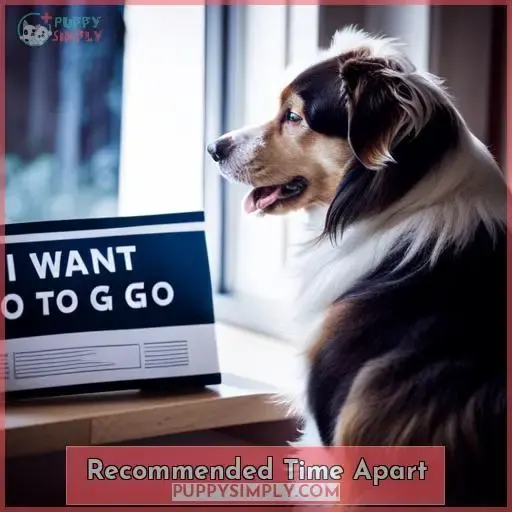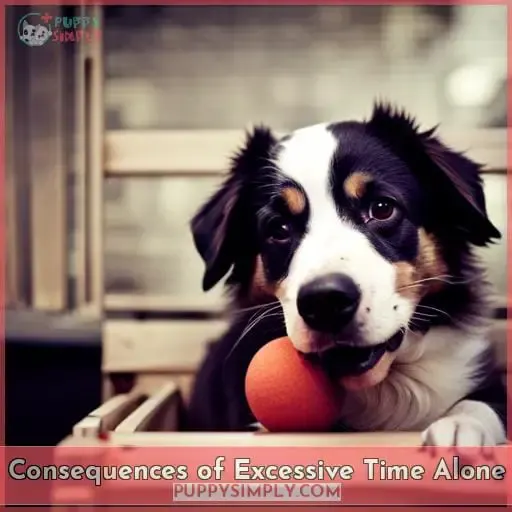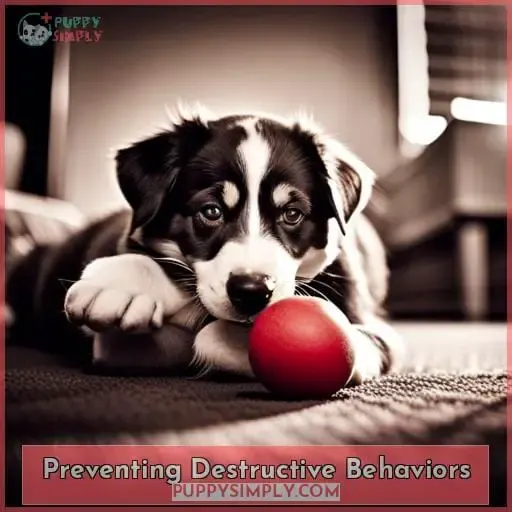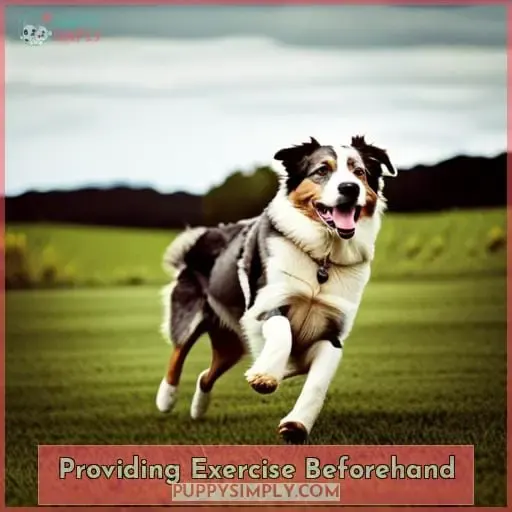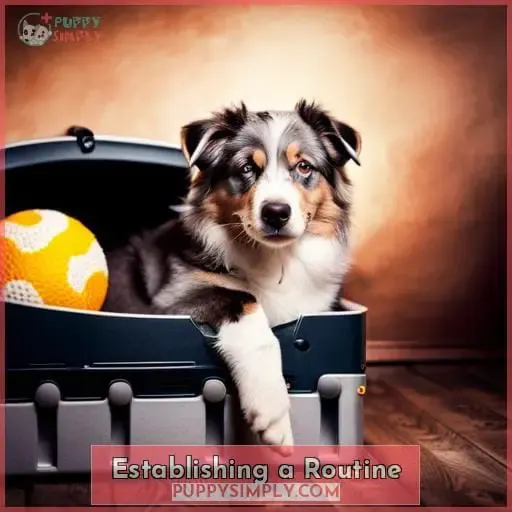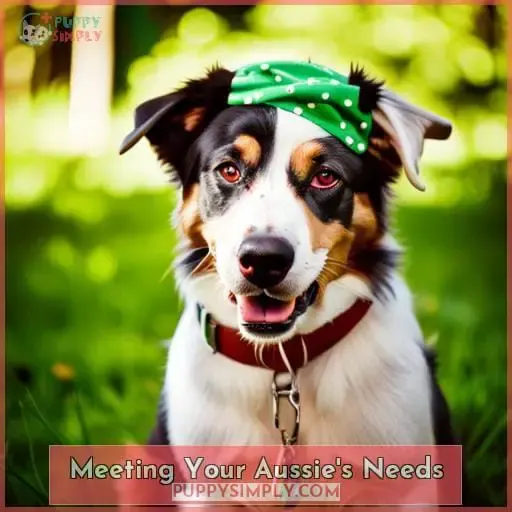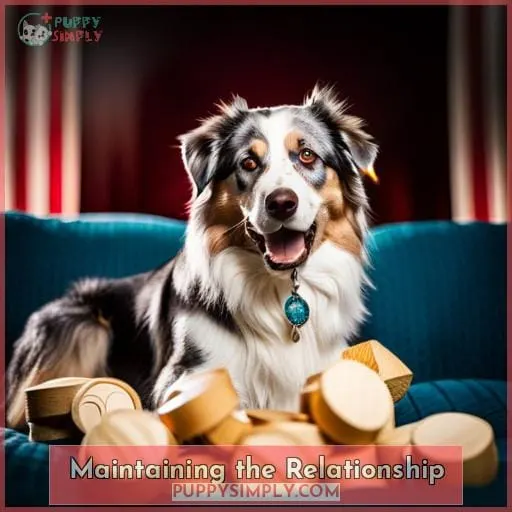This site is supported by our readers. We may earn a commission, at no cost to you, if you purchase through links.
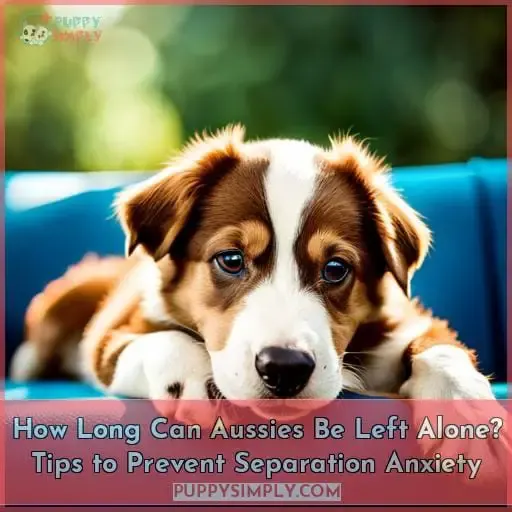 Whether for minutes or hours, leaving your loyal Aussie elicits worries. Will they cope with the isolation? Take comfort knowing this breed withstands time apart through preparation and understanding their needs.
Whether for minutes or hours, leaving your loyal Aussie elicits worries. Will they cope with the isolation? Take comfort knowing this breed withstands time apart through preparation and understanding their needs.
Providing puzzles, walks beforehand, Aussie-proofing your home curbs restlessness. Though eager for togetherness, consistency and meeting their energetic nature arms them to patiently await your return.
Table Of Contents
- Key Takeaways
- Should I Leave My Aussie Alone?
- Recommended Time Apart
- Consequences of Excessive Time Alone
- Preventing Destructive Behaviors
- Providing Exercise Beforehand
- Establishing a Routine
- Aussie Proofing Your Home
- Alternative Care Options
- Meeting Your Aussie’s Needs
- Maintaining the Relationship
- Frequently Asked Questions (FAQs)
- What are some mental stimulation toys I can leave for my Aussie when I’m gone?
- Is it okay to crate train my Aussie to prevent destructive behaviors when left alone?
- How can I ease my Aussie’s transition to being left alone for longer periods of time?
- What are signs my Aussie may be experiencing separation anxiety?
- If I have to leave my Aussie for more than 8 hours, what are some good options for doggie daycare in my area?
- Conclusion
Key Takeaways
- Recommended time apart depends on the dog’s age, starting with 1 hour per month of age for puppies under 6 months old
- Consequences of leaving Aussies alone too long can include separation anxiety, destructive behaviors, pacing, barking, digging, or escaping
- Prevent destructive behaviors by crate training, providing puzzle toys and calming aids, securing doors/windows, and using dog walkers or daycare
- Establish a routine for your Aussie with planned crating, walks, feeding schedules, potty breaks, and low-key departures to ease time alone
Should I Leave My Aussie Alone?
For up to 4 hours at a time, you should feel comfortable leaving your properly trained and exercised Aussie alone.
Ensure your Aussie is crate trained, well-socialized, and introduced to alone time gradually from a young age to set them up for success.
Leave them with interactive toys, background noise from the TV or radio to dampen outside sounds, and access to views outside to prevent them feeling isolated.
Occasionally change the toys available to keep things interesting.
Never make a fuss when leaving or returning.
Maintain normal energy levels.
With adequate physical and mental stimulation beforehand and preventative steps taken, your Aussie can handle time alone without stress or destructive behaviors arising.
Recommended Time Apart
You’re fine leaving your Aussie alone for up to 4 hours at a time.
As herding dogs, Aussies crave near-constant companionship, so leaving them for longer stretches can lead to separation anxiety.
To prevent this, establish a routine with adequate outdoor exercise beforehand.
Adolescent Aussies should have at least 1-2 hours of rigorous physical activity daily, split into multiple sessions. This allows them to expend pent-up mental and physical energy before alone time.
Additionally, incorporate mental exercises using interactive toys.
For pups under 6 months, limit alone time to an hour per month of age. Crate train them initially, and gradually increase independence.
With proper preparation, your loyal companion will feel comfortable resting while you’re apart, eagerly awaiting your return.
Consequences of Excessive Time Alone
If your Aussie is left by itself for too long, it may start to show signs of separation anxiety such as:
- Excessive barking
- Destructive chewing
- Pacing
- Attempting to escape
This anxious state stems from a deep-seated need for security and belonging.
When left alone for extended periods, your Aussie may resort to destructive behaviors like:
- Aggressively chewing furniture, door frames, walls, or anything else it can sink its teeth into.
- Frantically pacing or endlessly barking out of stress, loneliness, and boredom.
These behaviors can become ingrained if the underlying separation anxiety isn’t addressed.
Your Aussie needs plenty of exercise, mental stimulation, and quality time with you.
- Ease any transitions when you leave.
- Provide interactive toys for enrichment.
- Set up cameras to check in.
- Consider alternative care if you’ll be gone longer than 4 hours.
Meeting their social and psychological needs is key.
Preventing Destructive Behaviors
When left alone too long, your Aussie may start displaying destructive chewing, barking, digging, or escaping behaviors to cope with anxiety and boredom.
Crate training utilizing positive reinforcement establishes a safe space. Pair with puzzle toys like food-dispensing balls to occupy your dog mentally.
Should destructive tendencies persist, consult a certified trainer for a tailored desensitization program.
Securing doors/windows and providing a personalized space with familiar scents and bedding further prevents acting out.
Consider hiring a dog walker or using doggy daycare to supplement quality time when you must be away for long work hours.
Providing Exercise Beforehand
One should ensure their Aussie gets plenty of exercise before leaving them alone for an extended period.
A long walk or high energy play session is ideal to tire out an Aussie before you go.
Alternatively, provide mental stimulation through training games.
Consider crate training so your pup has a safe, comfortable space while you’re gone.
Aim for at least an hour of vigorous activity to wear out your high-energy Aussie.
Asking a friend or dog sitter to check in can also give your pup comfort if left over 4 hours.
Keeping your Aussie exercised will ease the transition when you must be away for long stretches.
Establishing a Routine
As your Aussie tires from playtime and training, it’s time to consider their routine when home alone.
A predictable schedule creates security. Implement planned crating, walks, feeding, and potty breaks. Adhere consistently, even varying only by 30 minutes on weekends. This steadiness eases anxiety triggered by prolonged isolation.
To reinforce calmness:
- Crate train through positive reinforcement
- Desensitize to leaving via gradual separations
- Keep departures/arrivals low-key
- Use music/toys when away
Routines grant comfort. By minding cues preceding your exit, your Aussie learns your pattern, expects the subsequent alone time, and accepts that you’ll return.
Aussie Proofing Your Home
Before you leave your Aussie alone for extended periods, dog-proof your home by putting away anything they could get into or destroy.
- Use baby gates to block off rooms with furniture or hazards.
- Tuck electrical cords out of reach and put plastic covers over outlets.
- Make sure trash cans have tight lids.
- Close interior doors and latch exterior doors and gates.
- Consider window screens or other barriers if your Aussie is prone to jumping at windows.
- Provide appropriate chew toys only and put away anything that could pose a choking risk, like children’s toys.
- Make their crate comfy with a bed and safe chew toy.
- And never leave food or counter surfing temptations unattended.
Taking some time to Aussie-proof creates a safer environment that prevents destructive behaviors when you can’t supervise.
Alternative Care Options
You can also consider alternative care options for your Aussie while you’re away, such as hiring a dog walker or taking them to doggy daycare. Both are great ways to provide your Aussie with exercise, mental stimulation, and socialization during the day.
Doggy daycares offer playgroups and walks for dogs to interact, play, and burn energy. Pet sitters can come by the house to walk your dog, feed them, and provide companionship.
If you’ll be gone for multiple days, trusted boarding kennels are an option so your Aussie isn’t alone overnight. Another idea is having a friend or neighbor check in on your dog – taking them out, playing fetch, or just petting them provides comfort too.
Whichever option you choose, make sure you find someone experienced with the sensitive nature of Aussies to care for all their physical and emotional needs.
Meeting Your Aussie’s Needs
Meeting your Aussie’s needs while you’re away is crucial to preventing separation anxiety.
Mental stimulation is key – provide puzzle toys and activities that engage their bright minds.
Continue training and socialization even when apart to build confidence.
Crate training with positive reinforcement creates a safe space.
Schedule play dates or dog walkers to ease loneliness.
Most importantly, quality time together strengthens your bond, fulfilling your Aussie’s core need for belonging.
Spend your reunions showing affection.
By meeting their physical and emotional needs, your Aussie learns that this routine meets their needs for safety and understanding too.
Maintaining the Relationship
Keep interacting positively with your Aussie when you’re together to cement your bond.
Make the most of your time together through activities like play, training, cuddling, and simply hanging out, which all build trust.
Give your pup focused attention, affection, and companionship so they feel secure with you.
Incorporate both physical and mental exercise into your routines to meet their needs for activity.
Play games, go on adventures outdoors, teach new commands – your dog will relish the stimulation.
By dedicating quality time to nurturing your relationship, your Aussie will be more independent and relaxed when left alone for reasonable periods, knowing that you reliably return.
Meeting their social and enrichment needs cements the human-canine bond that Aussies crave.
Frequently Asked Questions (FAQs)
What are some mental stimulation toys I can leave for my Aussie when I’m gone?
Try puzzle toys like Nina Ottosson puzzles or snuffle mats to engage their intellect.
Rotate toys to prevent boredom.
Food puzzles and chews make great options too.
The key is providing mental stimulation to occupy them while you’re out.
Is it okay to crate train my Aussie to prevent destructive behaviors when left alone?
Yes, crate training can help prevent destructive behaviors in Aussies left alone.
Confine them to an appropriately sized crate with a comfy bed when you’re gone. This protects your home and keeps them safe.
Pair crating with plenty of exercise beforehand so they rest while you’re out.
It should never be used punitively or for excessively long stretches.
How can I ease my Aussie’s transition to being left alone for longer periods of time?
Gradually increase alone time, providing puzzles/toys to occupy them.
Maintain exercise/play before departures.
Use calming aids like Thundershirts initially.
Reward calm behavior, not anxious pacing.
Be matter of fact upon exits/returns.
Make a reassuring routine around departures.
They’ll adjust with time and positive associations.
What are signs my Aussie may be experiencing separation anxiety?
Signs of separation anxiety in Aussies include:
- Excessive barking or howling
- Destructive chewing behaviors
- Pacing or circling
- Attempts to dig or escape
- Other distressed reactions when left alone.
Providing proper exercise, mental stimulation, and predictable routines can help prevent this.
Reach out for training advice if anxious behaviors persist.
If I have to leave my Aussie for more than 8 hours, what are some good options for doggie daycare in my area?
If you must leave your Aussie over 8 hours, thoroughly research and visit facilities beforehand.
- Look for engaging staff.
- Small groups.
- Temperament testing.
- Specialist experience with herding breeds.
This extra care can ease anxiety when apart.
Most importantly, find people you trust.
Conclusion
As an Aussie owner, you undoubtedly cherish every moment with your loyal companion. Though partings may come, take heart in knowing that with proper preparation, these clever pups can weather time alone.
Ensure their needs for activity and mental stimulation are met beforehand through walks, games, and puzzle toys. Maintain routines, provide safe spaces to relax, and reconsider arrangements if signs of distress appear.
For Aussies crave purpose – equip them to find meaning even in your absence, and rich joy awaits your reunion.


